Some of our readers are disappointed that we don’t rank-order foods. There are a couple of reasons for this. The most important: What is “best” for one dog may be disastrous for another. Every dog has to be fed with his or her unique needs and limitations in mind, just like humans. Everyone can’t eat the same thing and thrive! You wouldn’t insist on making your daughter with a serious allergy to shellfish eat pasta with clam sauce, just because the rest of the family is eating it. You wouldn’t serve rich, fatty dishes for every meal to your dieting spouse, forcing him to take only tiny portions to keep his caloric intake in check. So it doesn’t make sense for us to suggest that one company’s products are better than another company’s foods for every dog.
The second reason that we don’t rank foods has to do with a practical limitation: There is a correlation between expense and quality, but not everyone can afford to feed their dogs the most expensive foods. We think it’s far more valuable to teach you how to find the best products that are in your budget.
With these things in mind, let’s get started! We’ll start by discussing the act of walking into a pet supply store to start your search and then drill down into the finer points of comparing products and reading a food label.
Not your first wet dog food rodeo? Get our list right here.
See past canned dog food lists here.
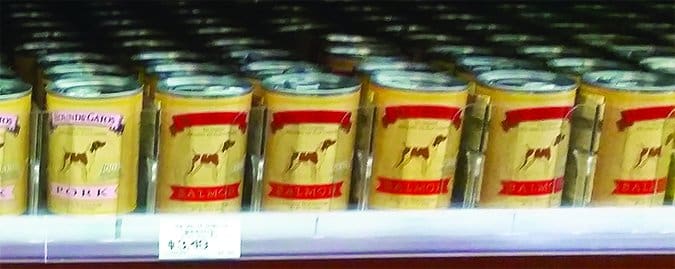
Pet Supply Stores
The type of store where you buy dog food dictates the kinds and quality of products you will find there. More dog food is sold by grocery stores than any other type of store, but the quality of the foods in grocery outlets is usually low. The products sold in pet specialty chain stores may represent the widest range in quality, with both inexpensive and high-quality products on the shelves. Independent pet supply stores, especially those that are geared toward consumers who are looking for so-called “natural” or “holistic” foods, generally carry the highest quality and most expensive foods. We would not expect to find any products of quality in mass-market stores such as Walmart.

Be aware that many pet food companies pay for premium positioning in stores. In fact, the most prominent or centrally located products are likely paying or reimbursing the store for this placement; the store manager’s favorite products (best-value or best-sellers) will usually be located adjacent to the “best” spots in the store. Lower-quality, low-cost foods are generally relegated to the lowest and farthest shelves.
Canned food accounts for a small percentage (about 15 percent) of most pet food companies’ total sales volume.
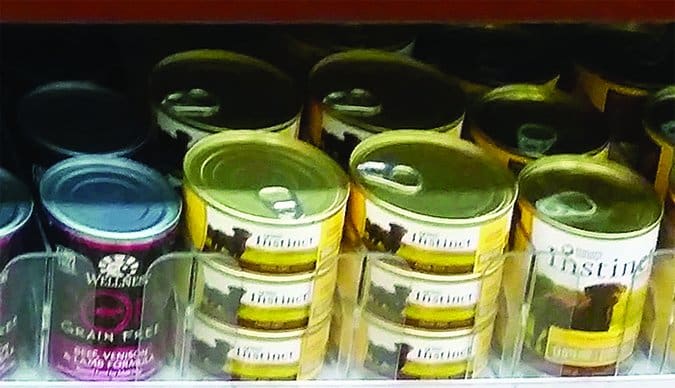
Most wet dog food (more than 80 percent) is packaged in cans in the U.S., but pouches and tubs or trays are gaining ground, as consumers discover the convenience offered by the greater variety of sizes available in the plastic containers. A caveat: Check the price per ounce to make sure one container isn’t far more expensive than another (divide the price by the number of ounces for each product and compare the results).

Shopping online? Advantages include the ability to try a wide variety of products, convenience, and often, if you can get free shipping (via Amazon Prime or by spending a retailer’s minimum amount), competitive pricing. But if you have any sort of problem with the food – say, your dog hates it or gets sick from it – returning it for a refund might be difficult.
Canned Food Labels: The Big Stuff
There are eight things required by law on a pet food label. The front label must contain the brand and product name, species for which the food is intended, and the quantity statement (how much is in the can). The next five requirements may appear on the back or back and side labels.
Many consumers don’t think very critically when it comes to the front label. If they see beautiful roasted chickens or grilled steaks, and fresh-scrubbed carrots or glistening apples, they may imagine that’s what’s in the food. But you really have to compare the art with the ingredients list (discussed in detail below).
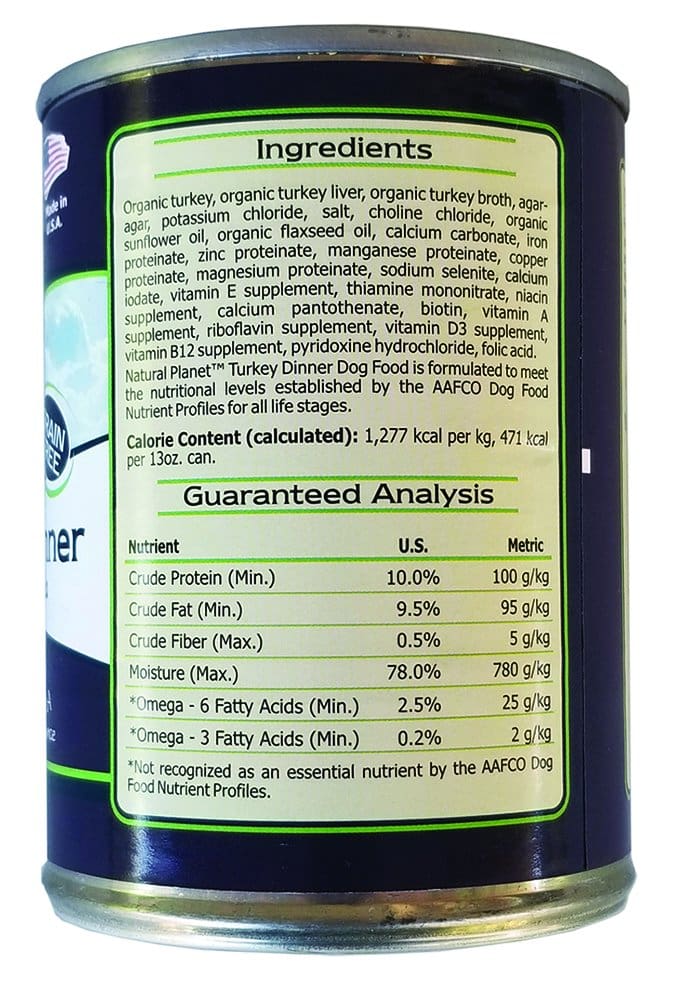
What’s far more important than the pictures is the verbiage used on the front. If the name of an ingredient is used in the product name (such as “Chicken & Rice Formula”), that named ingredients must comprise at least 70% of the total product by weight and at least 95% of the product not counting added water in the food. When more than one ingredient is in the name, no ingredient can be less than 3% the total product by weight. Because chicken is listed first in the name, there must be more chicken than rice in the recipe.
When the words “dinner,” “platter,” and “entrée” are used, a different rule is at work. The named ingredient in the phrase (for example, the “beef” in “Beef Dinner”) must comprise a minimum of 25% of the total ingredients.
If the word “with” is used (e.g., “Billy’s Dog Food With Chicken and Eggs”) the food is required to contain at least 3% of each named ingredient.
And if the word “flavor” is used, the requirement is that the food simply contain something that could convey that flavor; there is no minimum amount required.
The Fine Print on Dog Food Labels

The fourth requirement is the nutritional adequacy statement. Get out the magnifying glass! The “AAFCO statement” is very small on most labels, but contains very important information about which nutritional requirements the product has met.
AAFCO stands for “Association of American Feed Control Officials.” It is not a regulatory body, but it developed the nutritional standards used by all states. Somewhere on the label, usually very tiny, each dog food will state whether it is “complete and balanced” (or for “supplemental or intermittent feeding”), and whether this has been confirmed by a “feeding trial” or if it was formulated to meet certain nutritional standards. There are pros and cons of each method of confirmation.
Who is it for? The AAFCO statement will also specify who the food is meant for. All foods that are sold as “complete and balanced” must meet either the nutritional requirements for “growth and reproduction” (i.e., puppies) or the slightly lower requirements for “adult maintenance.” If a food says it can be fed to dogs “of all life stages,” it has met the higher nutritional requirements for a puppy food. Nutritionally, there is no difference between a food that meets the requirements for “all life stages” and a so-called puppy food – “all life stages” includes “growth and reproduction.” The kibble size of a “puppy” food might be smaller, but this is not a requirement!
However, if a food says it is complete and balanced for “adult maintenance,” it will not meet the higher nutritional needs of puppies.
Organic Dog Food
Organic claims are strictly defined. If the USDA Organic seal is present on the label, the product must contain a minimum of 95% organic ingredients.
The USDA’s National Organic Program regulates all organic crops, livestock, and agricultural products certified to the USDA’s organic standards. Organic certifiers inspect and verify compliance, and the certifier of each product must appear on the label, too. The USDA also conducts audits, investigations, and enforcement activities to ensure all products labeled organic meet its regulations.

If a product label says, “Made with organic ingredients,” the food must contain at least 70% organic ingredients, must state the certifier, and may not use the USDA Organic seal. If it specifies an ingredient that is organic (“Made with organic chicken”), all of the chicken in the product must be organic.
More Required Information
Dog food labels must bear the name and address of the manufacturer or distributor (requirement #5). We prefer the label to also contain the company’s phone number, but this is not required.
The “feeding directions” also must appear on the label (requirement #6). The statement must include the recommended amount of food to feed relative to the dog’s weight. This is calculated by a standard formula that says dogs require so many calories per pounds of body weight, but given the range of canine activity and metabolic rates, it can’t really be considered much more than a starting place. It is always necessary for owners to adjust their dogs’ rations based on how the dogs look and feel.
Dog Food Info That Matters Most: Guaranteed Analysis and…
The last two label requirements are the most critical. The “guaranteed analysis” (GA, requirement #7) gives you the minimum amount of protein and fat that are present in the food; they may be more, but there has to be at least that much. The GA also provides the maximum amount of moisture (water) and fiber that are present in the food.
Why the minimums and maximums? They use minimums for protein and fat because those are the most important values in a dog’s food; it’s what you are paying for. And they use maximums for moisture and fiber because this is not what you want to pay for – even though, with canned food, you actually are paying for a lot of it: Most canned dog foods contain about 78% to 85% moisture.
The fiber content of canned foods varies even more widely. Keep in mind that dogs have no dietary requirement for carbohydrates; they can live just fine on fat and protein alone. Canned foods that contain no carbohydrate source whatsoever will be pretty low in fiber – like, 1% maximum. In our opinion, there are better and far less expensive ways to supply your dog with fiber than in his canned food! It makes far more sense to use a canned dog food as a good source of protein and fat, and supply him with as much fiber as he may need to maintain a healthy weight and produce healthy stools through another source, such as fresh cooked or canned pumpkin, home-cooked grains (such as oatmeal, quinoa, or rice), home-cooked vegetables, or a dry dog food.
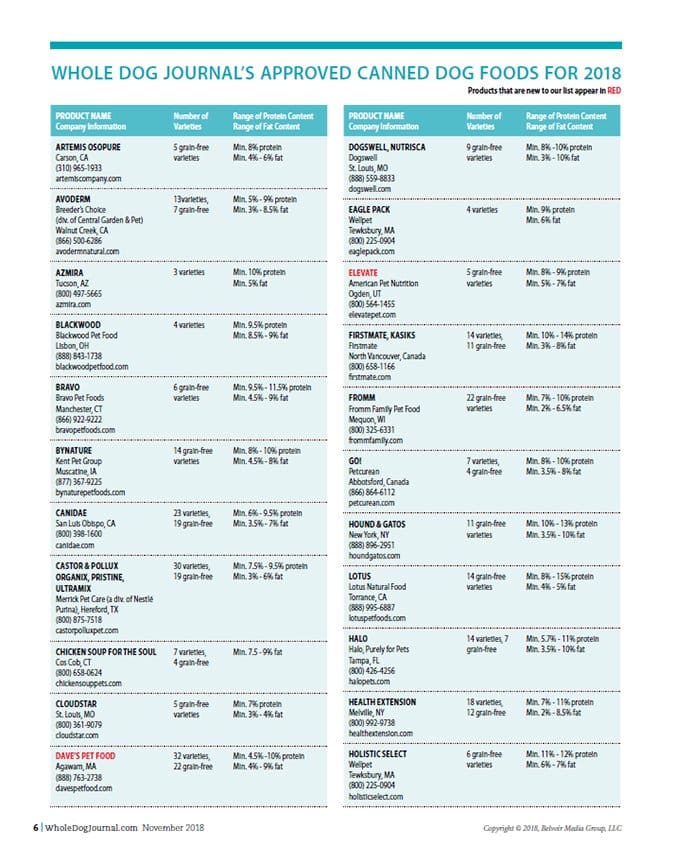
A final note on the GA: Manufacturers may (but are not required to) include other nutrient values on the GA. By doing so, they are literally guaranteeing those amounts in the food, and this is subject to testing and enforcement by state feed control officials. It’s a good way for a pet food maker to put their money where their mouths are concerning claims of special benefit from the inclusion of certain nutrients, such as DHA or glycosaminoglycans (e.g., chondroitin).
Ingredients, Ingredients, Ingredients
The ingredients list is the last legally required bit of information on the label. The ingredients must be named with regulated definitions – though a lot of manufacturers flirt with flowery adjectives meant to appeal to your palate, you know, your “farm-raised apples” and so on. (COME ON, people! Where else are you going to raise apples?!)
The ingredients must be listed in descending order of predominance by weight. Keep in mind that if an ingredients list starts with a fresh meat (which is awesome), water, and then a couple of carbohydrate sources – then, my dears, you are paying a lot for carbs.
One last note: Most canned foods contain “water sufficient for processing.” Canned foods do actually need a fairly high moisture content to mix and cook properly. We like it when a pet food company uses “broth” rather than water, but we are probably just getting hungry.
That’s it for the legal requirements; now, we’ll tell you what we look for when reading the ingredients label: WDJ’s canned dog food selection criteria. In order to appear on our “approved canned dog foods” list, a canned dog food must have the following:
Hallmarks of Quality Wet Dog Food
– A whole, named animal protein in one of the first two positions on the ingredients list. “Whole” means no by-products. “Named” means a specific animal species – chicken, beef, pork, lamb – as opposed to “meat” or “poultry.” Look for products with the highest possible inclusion of top-quality animal proteins; in other words, choose a product with the animal product listed first over a product that lists water (or broth) first and the animal product second.
– If a fat source is present, it must be named (“chicken fat” rather than “animal fat”).
– If vegetables, grains, or other carb sources are used, we prefer to see them whole, rather than by-products (for example, potatoes rather than potato starch).
Disqualifiers
We will not approve a canned dog food that contains:
– An unnamed animal protein or fat source, such as “meat,” “poultry,” or “animal fat.”
– Any meat byproducts or poultry byproducts.
– Any animal plasma product.
– Wheat gluten, which may be used as a cheap source of plant protein, a thickener, and/or a binder, holding together artificially formed “chunks” of ground meat.
– Sugar, molasses, or other sweeteners.
– Artificial colors, flavors, or preservatives.
Attached is a list of companies that make canned foods that meet our selection criteria. Keep in mind that any manufacturer may make a product or two that does not meet our selection criteria. If you compare the ingredients with our list of criteria, you will easily identify the few products that contain some wheat gluten or pork plasma without our knowledge. Blech! But if they meet the criteria above, they fit your budget, and suit your dog, they have our blessing.


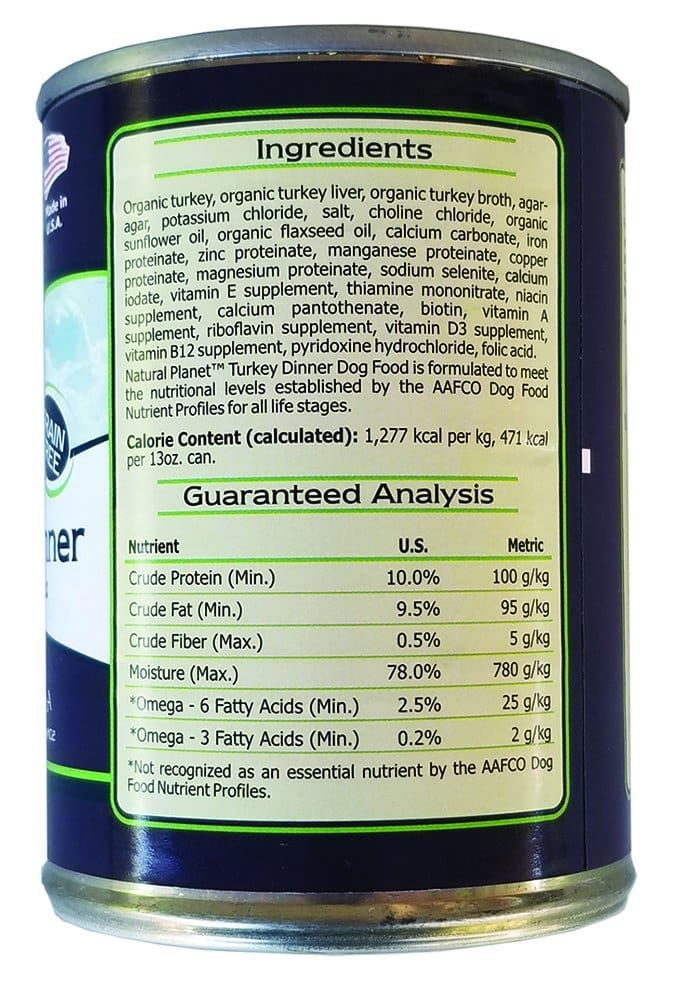
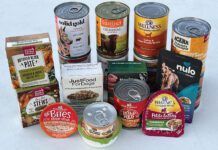
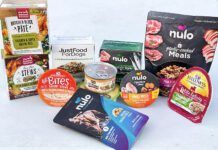

this a joke to figure this out
That above list ends with H. Surely there are names beyond H that are on your approved list. None of the links seem to go anywhere to find anything further.
just scroll down – it is there! I just looked
We moved all 22 yeas of WDJ to a new website provider, and we have definitely had a few wrinkles to iron out. However, I just clicked on the link, and then scrolled down; there is a second page of company names after the H’s. Perhaps someone already fixed it? Try again and comment if you are still having trouble, if you would.
Question. Why does WDJ recommend against plasma in dog food? I see that foods containing plasma don’t make the list, but why? Thanks!
the links do not work
If I am remembering correctly, I seem to remember that one of your criteria also was that the manufacturer had to agree to allow WDJ folks to inspect the plant. Is that still a requirement?
The list of canned food is incomplete. No way to scroll down.
Its working fine for me, 2 pages. Viewed/printed no problem.